Is AI suitable for a spring-calving suckler herd? Can sexed semen be used to good effect in a suckler herd? Many will argue that trying to inseminate suckler cows in the month of June is extremely difficult and time-consuming and will never match the results of a stock bull. In some cases, this may be true. But like everything, there is always an exception and Co Fermanagh suckler farmer John Egerton has been successfully using AI for the past 13 years with results that even the best stock bulls would struggle to achieve.
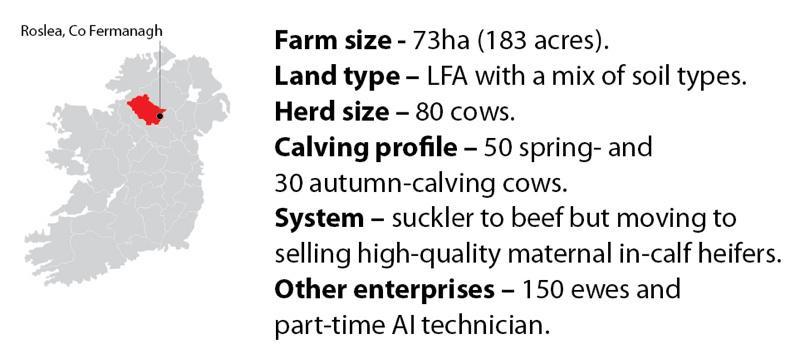
John runs an 80-cow suckler-to-beef herd in Co Fermanagh on the outskirts of Rosslea village. He epitomises top-class management in all aspects of livestock farming, from grassland to health and breeding.
The day-to-day management is a family effort, with wife Elizabeth and sons William, Samuel and Robert providing invaluable assistance throughout the year and all are keen to play their part in the smooth running of the farm.
The suckler herd is split between spring and autumn calving. Cattle are finished through ABP Newry. Spring-born males are finished as steers at 20 months of age, averaging 360kg on 0.5t of concentrates. Autumn bulls are finished at 15 months of age at a similar weight on 1t concentrates/head. Heifers are finished at 20 months at 320kg.
Background
In 2002, John Egerton took over the management of his suckler herd and made the decision to change the breeding programme. Up until then, the herd was typical of many NI suckler herds in the west of the province. Replacements were purchased through the marts as either in-calf animals or calved cows. Limousin-cross animals were usually purchased for cows.
Back then, the 50-cow suckler herd used two Charolais stock bulls for breeding. All calves were marketed through one outlet – the weanling ring.
“Buyers in the marts wanted Charolais cattle. But trying to produce the real flashy show calf meant you were going to have calving problems and that meant a few dead calves every year. There were no performance figures available, which made it hard to source stock bulls with calving ease,” says John.
Keeping calm and moving at the animal’s pace will help to keep the cow calm, helping conception rates
Continued calving problems meant there was a high turnover of cows every year. “We would have had around five or six caesareans every year and a large number of cows that needed the calf jacked. Things needed to change. We were calving cows all year round and having to continually buy in cows to replace those that were culled because of calving difficulty. While we got great prices for weanlings, it didn’t compensate for the losses.”
A second reason behind the move to AI was the lack of good-quality replacements in the marts. “More often than not, when buying in the mart you were buying in the problem cows that another herd was selling, whether that was poor fertility, lack of milk, cows that had lost a quarter or cows that were mad at calving time. In-calf heifers were not too bad but occasionally had poor temperament. I just felt that the quality of cows in the mart was not good enough to drive the profitability of my herd forward,” adds John.
Trying to source proven maternal stock bulls back in 2002 was a difficult task as most pedigree breeders were focused on producing terminal sires. At the time, John didn’t want to compromise calf quality by purchasing a traditional beef breed. He had some experience of using AI and decided that going down the AI route would be the best option for the herd.
Breeding policy
After completing an AI course, he started to inseminate all cows and use the stock bull as a backup for sweeping cows. However, in his second year inseminating cows there was only one cow that had not held to AI, so the stock bull was sold. Since then the herd has used 100% AI for breeding.
“I decided to use Salers in the early years to breed cows and the main focus was on calving ease more so than milk. As a result, my cows probably lost a bit of milk. But I was able to get more live calves on the ground and able to get cows back in-calf. I was still using Charolais sires on cows that were not suitable for breeding replacements,” says John.
The next step was trying to get the calving spread tightened. Calving a few cows every month of the year was a drain on labour. “I had calves of all ages which constantly needed different management tasks and trying to AI suckler cows that calved all year round was extremely difficult. The herd was split into a spring and an autumn herd and this simplified things greatly. Once established, there was no way I would go back to calving all year round.”
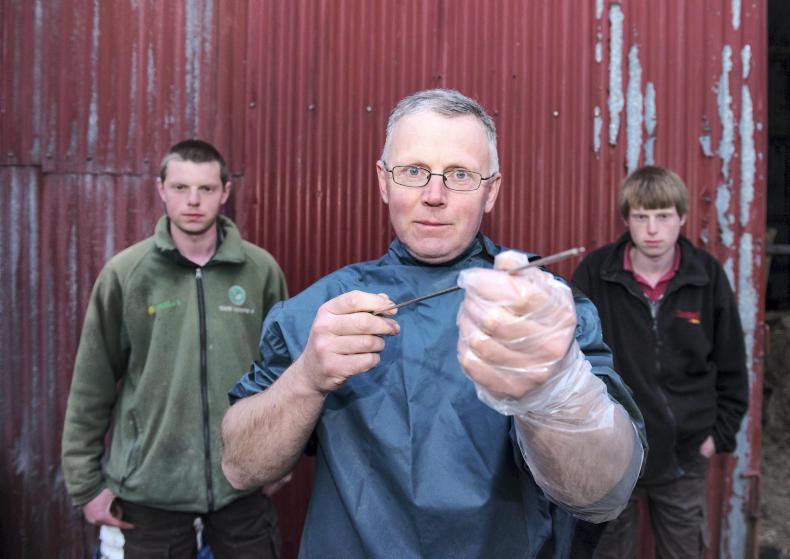
John Egerton with his sons Samuel and Robert. \ Barry CroninJohn Egerton with his sons Samuel and Robert. \ Barry Cronin
Farming in Fermanagh brings challenges with difficult ground conditions due to high levels of rainfall. Having cows in excess of 700kg liveweight would cause severe ground damage and probably require re-housing during periods of prolonged rainfall.
Managing cow size was important as lighter cows could have a longer grazing season each year, reducing feed costs. The focus was on breeding a medium-size cow around 600kg that was capable of gaining condition from grass and had excellent docility to suit AI.
“I wanted a nice moderate-size cow that suits the land and can gain condition at grass. I want my cows to work for me, not the other way around. A cow that cannot be grazed in spring and autumn is too costly to keep.”
High fertility
John’s breeding policy is clearly working when reviewing breeding records. Since 2011, the 50-cow herd has increased to 80 breeding females, with the extra cows homebred as the herd is completely closed. The increase in herd size was gradual, with five or six extra heifers every year.
The spring herd now consists of 50 cows calving over a six-week period from early March to mid-April. The autumn herd of 30 cows also calves in six weeks from early August. Last autumn, all but two of the autumn herd calved in August, which is 93% calved in four weeks.
Typical conception rates to first service of 90% are exceptional, considering that cows and heifers are all served to natural heats. That means approximately eight cows repeat and need a second service. In total, this means 88 straw and inseminations per year which priced at €20 costs €1,760.
While this may be the price of some stock bulls, it would not purchase top-class genetics that John is getting access to. With AI, he can use the top sires on all his cows. Also, a herd of 80 cows would require at least three stock bulls to suit compact calving – two for the cows and one for heifers. “There will be days that multiple cows are in heat and a stock bull may not cover them all. Whereas with AI, if we pick up several cows in heat we can serve them all.”
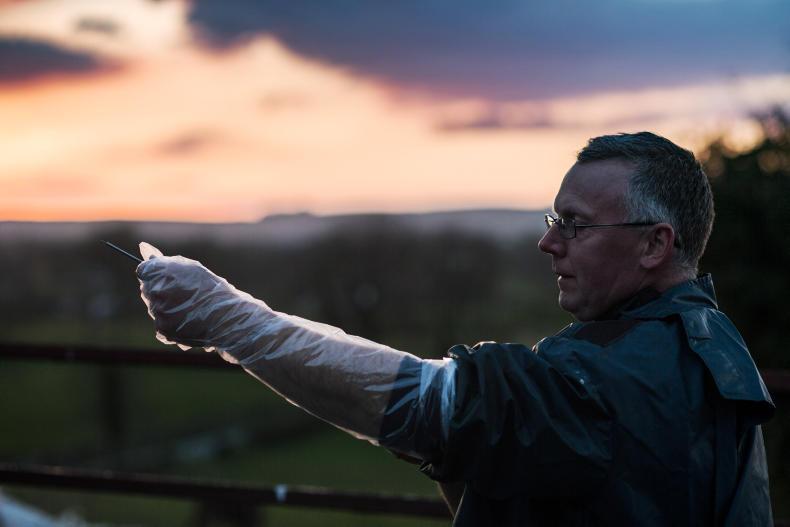
With AI, John can use the top sires on all his cows. As the herd breeds its own replacements, there would a high turnover of bulls with so many daughters in the herd. The bulls also have to be grazed and wintered, which would require building pens adding costs to John’s system.
Heat detection
All inseminating is carried out by John. Heat detection starts in mid-May, around three weeks in advance of the breeding season.
Cow’s numbers and the dates of observed heats are recorded so as they can be quickly identified for repeat heats three weeks later. Cows are observed at least four times per day. Morning and late evening are the two main periods when cows are picked up in heat. John’s wife Elizabeth is responsible for a large share of monitoring cows for heats during the day.
“We monitor cows for a minimum of 20 minutes morning and night. They will also be checked around lunchtime and mid-afternoon. I have noticed over the years that the spring cows show stronger heats in late evening. Having cows calving in a tight group makes it easier to monitor heats as cows are cycling close together and there is plenty of activity. The same with heifers – having a group of even sized heifers helps to increase heat activity.”
John follows the am-pm rule for inseminating cows. Once identified, the cow will be slipped out on to a laneway and calmly walked into the handling race for inseminating and returned to grass as soon as possible.

"Keeping calm and moving at the animal’s pace will help to keep the cow calm, helping conception rates." \ Barry Cronin“It is important not to rush the process as you will stress yourself and the cow. Keeping calm and moving at the animal’s pace will help to keep the cow calm, helping conception rates.”
Cows are scanned and empty cows are sold off-farm. There is no slipping of empty cows between the spring and autumn herds.
Sexed semen
Maternal Limousin and Simmental bulls were used in an effort to improve milk but as luck would have it, the calves born were mostly bull calves. So in 2012, John decided to take the next step in using AI and started using sexed semen on heifers and with good results.
Whitebog Convenor, a Salers bull, was initially used and more recently, sexed Shorthorn semen has been used. Conception rates to first service are typically around 80%, which is well ahead of normal industry figures. Last autumn, eight heifers were inseminated with sexed semen, with 100% of animals holding to first service. The first sexed heifers from the spring herd were born in 2014 and have calved successfully in March 2016 at 24 months old. The sexed heifers are of tremendous quality and possess excellent milk.
Sexed semen is now used on all spring and autumn replacements and a number of select cows. Heifers all get one straw of sexed semen and any repeats are served with conventional straws. Cows that calve in the first three weeks of the calving pattern will also be offered sexed semen, with the remainder crossed to a terminal continental sire.
“Sexed semen has worked well on farm and I will gradually increase its use to expand the autumn herd to 50 cows in future. Sexed semen is not for everyone, as it has lower conception rates than conventional semen. If you have a cow with poor fertility, then sexed semen will not work. I have noticed this over the past few years – if there is a problem with the cow’s fertility, diet or the animal is stressed, she will not conceive to sexed semen but she will hold to conventional semen.”
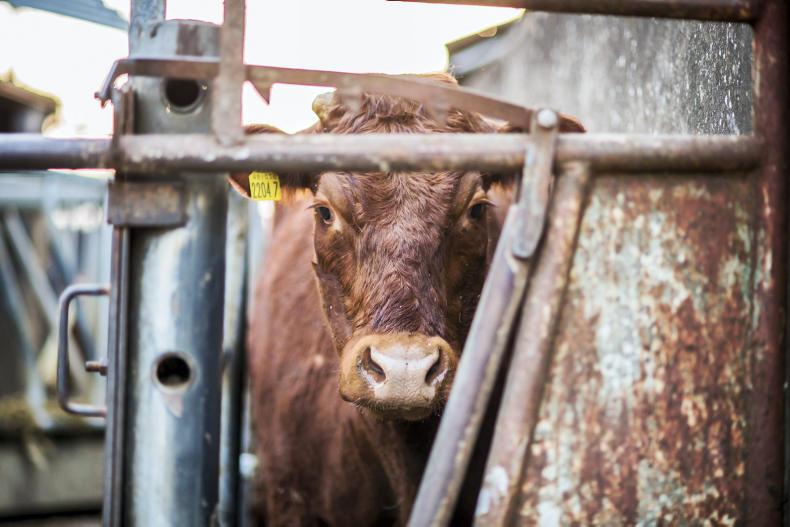
Age at first calving for all heifers is 24 months. \ Barry CroninAdding value
With the herd now producing over 70% female calves, John is in a strong position to add value to cattle sales. Surplus heifers have been sold in-calf once scanned at 17 to 18 months of age. Eight heifers were sold off grass last autumn at £1,300/head compared to a few empty heifers that were finished at 20 months. The finished heifers made £1,100 and consumed £100 worth of concentrate during the intensive feeding period.
“The surplus heifers have been in demand and have been a good selling option compared to beef. At the minute, I would take a heifer calf over a male calf because it can be sold in-calf off grass for a higher price.”
Age at first calving for all heifers is 24 months and has been for a long time. All spring-calving heifers will calve for a second time without any problem although the autumn heifers do require additional feed and attention to get them back in-calf again.
“Autumn heifers need to be that bit stronger and be able to hold their flesh to get them bred again as autumn grass quality is lower than it is in spring. But autumn calving works well on the farm as it spreads cashflow and allows for a higher stocking rate.

Docility
As the spring-calving herd is bred during the grazing season, docility was required because cows would have to be brought in and out of the handling pens for inseminating. Cows with poor temperament who are difficult to bring out off fields would become stressed and the chance of a successful insemination was unlikely.
Salers have gained a reputation as cattle with a temperament issue, which is unfair. On John’s farm, his cows are seriously docile even at calving, although caution is always practised.
“Cattle are used to being handled on the farm. Cows and calves are grazed in two- and three-day paddocks. They get used to me or any of my sons very quickly. When they see us coming they know they are being moved to fresh grass and are happy to follow.
“Weaned calves are also allowed out to graze for a few hours most days in winter, which again gets them used with being handled. We also weigh cattle regularly from an early age so they become used to moving in and out of the yard without anyone having to shout and prod cattle with sticks. This stands to us in the long run as it produces cows that are quiet and rarely troubled by strangers. Even when discussion groups come to visit the farm, the cows are never bothered by large groups and will come up to people and lick at them.”
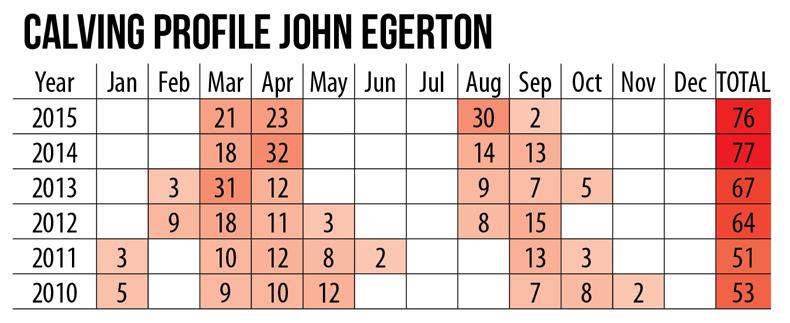
Future direction
The plans are to eventually grow the herd to 100 cows. This will come through increasing the autumn herd as these animals are weaned before turnout and therefore have a lower grazing demand than spring-calving cows. However, they do have added costs and require a higher standard of management.
Use of sexed semen will grow gradually to try and produce more females for sale as replacements. AI is here to stay on the farm. “There has been massive progress in genetics in recent years which means AI is the fastest way to improve the quality of the whole herd. You can select a team of bulls that best suit all cows. I am hoping there will be more choice for sexed semen sires in future also so as we can keep improving our own herd.”
This article first appeared in the Irish Farmers Journal Beef magazine. Read more:
Watch: heifer breeding that didn’t go to plan
From autumn to spring calving in Co Antrim
Is AI suitable for a spring-calving suckler herd? Can sexed semen be used to good effect in a suckler herd? Many will argue that trying to inseminate suckler cows in the month of June is extremely difficult and time-consuming and will never match the results of a stock bull. In some cases, this may be true. But like everything, there is always an exception and Co Fermanagh suckler farmer John Egerton has been successfully using AI for the past 13 years with results that even the best stock bulls would struggle to achieve.

John runs an 80-cow suckler-to-beef herd in Co Fermanagh on the outskirts of Rosslea village. He epitomises top-class management in all aspects of livestock farming, from grassland to health and breeding.
The day-to-day management is a family effort, with wife Elizabeth and sons William, Samuel and Robert providing invaluable assistance throughout the year and all are keen to play their part in the smooth running of the farm.
The suckler herd is split between spring and autumn calving. Cattle are finished through ABP Newry. Spring-born males are finished as steers at 20 months of age, averaging 360kg on 0.5t of concentrates. Autumn bulls are finished at 15 months of age at a similar weight on 1t concentrates/head. Heifers are finished at 20 months at 320kg.
Background
In 2002, John Egerton took over the management of his suckler herd and made the decision to change the breeding programme. Up until then, the herd was typical of many NI suckler herds in the west of the province. Replacements were purchased through the marts as either in-calf animals or calved cows. Limousin-cross animals were usually purchased for cows.
Back then, the 50-cow suckler herd used two Charolais stock bulls for breeding. All calves were marketed through one outlet – the weanling ring.
“Buyers in the marts wanted Charolais cattle. But trying to produce the real flashy show calf meant you were going to have calving problems and that meant a few dead calves every year. There were no performance figures available, which made it hard to source stock bulls with calving ease,” says John.
Keeping calm and moving at the animal’s pace will help to keep the cow calm, helping conception rates
Continued calving problems meant there was a high turnover of cows every year. “We would have had around five or six caesareans every year and a large number of cows that needed the calf jacked. Things needed to change. We were calving cows all year round and having to continually buy in cows to replace those that were culled because of calving difficulty. While we got great prices for weanlings, it didn’t compensate for the losses.”
A second reason behind the move to AI was the lack of good-quality replacements in the marts. “More often than not, when buying in the mart you were buying in the problem cows that another herd was selling, whether that was poor fertility, lack of milk, cows that had lost a quarter or cows that were mad at calving time. In-calf heifers were not too bad but occasionally had poor temperament. I just felt that the quality of cows in the mart was not good enough to drive the profitability of my herd forward,” adds John.
Trying to source proven maternal stock bulls back in 2002 was a difficult task as most pedigree breeders were focused on producing terminal sires. At the time, John didn’t want to compromise calf quality by purchasing a traditional beef breed. He had some experience of using AI and decided that going down the AI route would be the best option for the herd.
Breeding policy
After completing an AI course, he started to inseminate all cows and use the stock bull as a backup for sweeping cows. However, in his second year inseminating cows there was only one cow that had not held to AI, so the stock bull was sold. Since then the herd has used 100% AI for breeding.
“I decided to use Salers in the early years to breed cows and the main focus was on calving ease more so than milk. As a result, my cows probably lost a bit of milk. But I was able to get more live calves on the ground and able to get cows back in-calf. I was still using Charolais sires on cows that were not suitable for breeding replacements,” says John.
The next step was trying to get the calving spread tightened. Calving a few cows every month of the year was a drain on labour. “I had calves of all ages which constantly needed different management tasks and trying to AI suckler cows that calved all year round was extremely difficult. The herd was split into a spring and an autumn herd and this simplified things greatly. Once established, there was no way I would go back to calving all year round.”

John Egerton with his sons Samuel and Robert. \ Barry CroninJohn Egerton with his sons Samuel and Robert. \ Barry Cronin
Farming in Fermanagh brings challenges with difficult ground conditions due to high levels of rainfall. Having cows in excess of 700kg liveweight would cause severe ground damage and probably require re-housing during periods of prolonged rainfall.
Managing cow size was important as lighter cows could have a longer grazing season each year, reducing feed costs. The focus was on breeding a medium-size cow around 600kg that was capable of gaining condition from grass and had excellent docility to suit AI.
“I wanted a nice moderate-size cow that suits the land and can gain condition at grass. I want my cows to work for me, not the other way around. A cow that cannot be grazed in spring and autumn is too costly to keep.”
High fertility
John’s breeding policy is clearly working when reviewing breeding records. Since 2011, the 50-cow herd has increased to 80 breeding females, with the extra cows homebred as the herd is completely closed. The increase in herd size was gradual, with five or six extra heifers every year.
The spring herd now consists of 50 cows calving over a six-week period from early March to mid-April. The autumn herd of 30 cows also calves in six weeks from early August. Last autumn, all but two of the autumn herd calved in August, which is 93% calved in four weeks.
Typical conception rates to first service of 90% are exceptional, considering that cows and heifers are all served to natural heats. That means approximately eight cows repeat and need a second service. In total, this means 88 straw and inseminations per year which priced at €20 costs €1,760.
While this may be the price of some stock bulls, it would not purchase top-class genetics that John is getting access to. With AI, he can use the top sires on all his cows. Also, a herd of 80 cows would require at least three stock bulls to suit compact calving – two for the cows and one for heifers. “There will be days that multiple cows are in heat and a stock bull may not cover them all. Whereas with AI, if we pick up several cows in heat we can serve them all.”

With AI, John can use the top sires on all his cows. As the herd breeds its own replacements, there would a high turnover of bulls with so many daughters in the herd. The bulls also have to be grazed and wintered, which would require building pens adding costs to John’s system.
Heat detection
All inseminating is carried out by John. Heat detection starts in mid-May, around three weeks in advance of the breeding season.
Cow’s numbers and the dates of observed heats are recorded so as they can be quickly identified for repeat heats three weeks later. Cows are observed at least four times per day. Morning and late evening are the two main periods when cows are picked up in heat. John’s wife Elizabeth is responsible for a large share of monitoring cows for heats during the day.
“We monitor cows for a minimum of 20 minutes morning and night. They will also be checked around lunchtime and mid-afternoon. I have noticed over the years that the spring cows show stronger heats in late evening. Having cows calving in a tight group makes it easier to monitor heats as cows are cycling close together and there is plenty of activity. The same with heifers – having a group of even sized heifers helps to increase heat activity.”
John follows the am-pm rule for inseminating cows. Once identified, the cow will be slipped out on to a laneway and calmly walked into the handling race for inseminating and returned to grass as soon as possible.

"Keeping calm and moving at the animal’s pace will help to keep the cow calm, helping conception rates." \ Barry Cronin“It is important not to rush the process as you will stress yourself and the cow. Keeping calm and moving at the animal’s pace will help to keep the cow calm, helping conception rates.”
Cows are scanned and empty cows are sold off-farm. There is no slipping of empty cows between the spring and autumn herds.
Sexed semen
Maternal Limousin and Simmental bulls were used in an effort to improve milk but as luck would have it, the calves born were mostly bull calves. So in 2012, John decided to take the next step in using AI and started using sexed semen on heifers and with good results.
Whitebog Convenor, a Salers bull, was initially used and more recently, sexed Shorthorn semen has been used. Conception rates to first service are typically around 80%, which is well ahead of normal industry figures. Last autumn, eight heifers were inseminated with sexed semen, with 100% of animals holding to first service. The first sexed heifers from the spring herd were born in 2014 and have calved successfully in March 2016 at 24 months old. The sexed heifers are of tremendous quality and possess excellent milk.
Sexed semen is now used on all spring and autumn replacements and a number of select cows. Heifers all get one straw of sexed semen and any repeats are served with conventional straws. Cows that calve in the first three weeks of the calving pattern will also be offered sexed semen, with the remainder crossed to a terminal continental sire.
“Sexed semen has worked well on farm and I will gradually increase its use to expand the autumn herd to 50 cows in future. Sexed semen is not for everyone, as it has lower conception rates than conventional semen. If you have a cow with poor fertility, then sexed semen will not work. I have noticed this over the past few years – if there is a problem with the cow’s fertility, diet or the animal is stressed, she will not conceive to sexed semen but she will hold to conventional semen.”

Age at first calving for all heifers is 24 months. \ Barry CroninAdding value
With the herd now producing over 70% female calves, John is in a strong position to add value to cattle sales. Surplus heifers have been sold in-calf once scanned at 17 to 18 months of age. Eight heifers were sold off grass last autumn at £1,300/head compared to a few empty heifers that were finished at 20 months. The finished heifers made £1,100 and consumed £100 worth of concentrate during the intensive feeding period.
“The surplus heifers have been in demand and have been a good selling option compared to beef. At the minute, I would take a heifer calf over a male calf because it can be sold in-calf off grass for a higher price.”
Age at first calving for all heifers is 24 months and has been for a long time. All spring-calving heifers will calve for a second time without any problem although the autumn heifers do require additional feed and attention to get them back in-calf again.
“Autumn heifers need to be that bit stronger and be able to hold their flesh to get them bred again as autumn grass quality is lower than it is in spring. But autumn calving works well on the farm as it spreads cashflow and allows for a higher stocking rate.

Docility
As the spring-calving herd is bred during the grazing season, docility was required because cows would have to be brought in and out of the handling pens for inseminating. Cows with poor temperament who are difficult to bring out off fields would become stressed and the chance of a successful insemination was unlikely.
Salers have gained a reputation as cattle with a temperament issue, which is unfair. On John’s farm, his cows are seriously docile even at calving, although caution is always practised.
“Cattle are used to being handled on the farm. Cows and calves are grazed in two- and three-day paddocks. They get used to me or any of my sons very quickly. When they see us coming they know they are being moved to fresh grass and are happy to follow.
“Weaned calves are also allowed out to graze for a few hours most days in winter, which again gets them used with being handled. We also weigh cattle regularly from an early age so they become used to moving in and out of the yard without anyone having to shout and prod cattle with sticks. This stands to us in the long run as it produces cows that are quiet and rarely troubled by strangers. Even when discussion groups come to visit the farm, the cows are never bothered by large groups and will come up to people and lick at them.”

Future direction
The plans are to eventually grow the herd to 100 cows. This will come through increasing the autumn herd as these animals are weaned before turnout and therefore have a lower grazing demand than spring-calving cows. However, they do have added costs and require a higher standard of management.
Use of sexed semen will grow gradually to try and produce more females for sale as replacements. AI is here to stay on the farm. “There has been massive progress in genetics in recent years which means AI is the fastest way to improve the quality of the whole herd. You can select a team of bulls that best suit all cows. I am hoping there will be more choice for sexed semen sires in future also so as we can keep improving our own herd.”
This article first appeared in the Irish Farmers Journal Beef magazine. Read more:
Watch: heifer breeding that didn’t go to plan
From autumn to spring calving in Co Antrim













 This is a subscriber-only article
This is a subscriber-only article















SHARING OPTIONS: